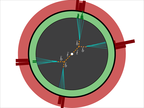CLASSE NEWS | 13 May 2014
 Supersymmetry is one of the most interesting possibility for extending the Standard Model and incorporate new particles at the TeV scale. However, the absence of new particles at the LHC is making the traditional approaches to supersymmetry less appealing. Prof. Csaki, together with his collaborators Eric Kuflik and Tomer Volansky from Tel Aviv University, has recently proposed a new type of supersymmetric extension of the Standard Model. The main point of the proposal is that that so-called R-parity violating terms, which can lead to important consequences for the phenomenology of the model, can have a very different origin and form than previously considered. This new form of the R-parity violating terms might require a re-analysis of the LHC data for establishing bounds on supersymmetry, leading to weaker constraints on supersymmetric particles. Csaki's article on the subject has been recently published in Physical Review Letters, where it received the additional endorsement of being included among the "Editor's choice" articles.
Supersymmetry is one of the most interesting possibility for extending the Standard Model and incorporate new particles at the TeV scale. However, the absence of new particles at the LHC is making the traditional approaches to supersymmetry less appealing. Prof. Csaki, together with his collaborators Eric Kuflik and Tomer Volansky from Tel Aviv University, has recently proposed a new type of supersymmetric extension of the Standard Model. The main point of the proposal is that that so-called R-parity violating terms, which can lead to important consequences for the phenomenology of the model, can have a very different origin and form than previously considered. This new form of the R-parity violating terms might require a re-analysis of the LHC data for establishing bounds on supersymmetry, leading to weaker constraints on supersymmetric particles. Csaki's article on the subject has been recently published in Physical Review Letters, where it received the additional endorsement of being included among the "Editor's choice" articles.
New Paradigm for Supersymmetric Theories

A characteristic event in an LHC detector predicted by the dynamical RPV scenario, with two displaced 'stop' particles decaying to four bottom quarks.
